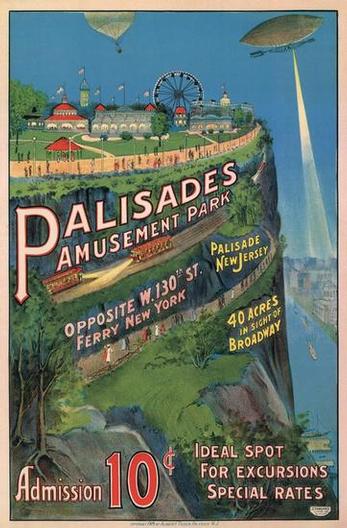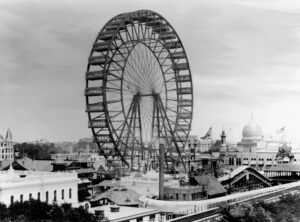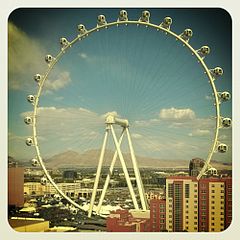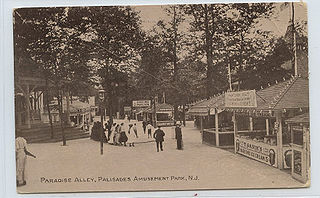
Today, June 21, is the Summer Equinox, the first official day of summer, and also the longest day of the year in the Northern Hemisphere. It’s true. Summer vacation has arrived. Whether you vacation elsewhere or staycation near your home base, it’s time to get outside and enjoy the sun — with sun protection, of course. 😎
Amusement parks are a popular choice for day trips to places with hot dogs, cotton candy, and rides. There are many rides to chose from – bumper cars, the tunnel of love, and rollar coasters are among the best known. But the premier carnival ride in any permanent or semi-permanent amusement park is the Ferris Wheel.
The First Observational Wheel
In 1891, William Somers built a wooden wheel above the boardwalk in Atlantic City and called it the Observational Roundabout. It was 50 feet high and had a coal-fired engine to propel it. In 1892 George Washington Gale Ferris, Jr. bought a ticket to the new attraction, but he was more interested in the mechanics of Somers’ wheel than he was in the view.
The previous year, architect Daniel Burnham took a commission to create the Chicago World’s Fair and Columbian Exposition on 1-square mile of vacant land. Burnam needed something memorable to make the exposition stand out. At the 1889 World’s Fair held in Paris, the 300 meter Eiffel Tower became a global sensation. Burnam wanted an attraction that was bigger and better. He challenged his engineers, including Ferris, to think big. That’s probably when Ferris decided to check out Somers’ wooden wheel. Ferris developed plans for a steel wheel, but when he showed the plans to Burnham, his boss thought the design was too fragile. Ferris didn’t take “no” for an answer. To prove the viability of his plans, Ferris recruited investors, spent $25,000 on safety studies, and convinced Burnham a steel vertical wheel was the best way to surpass the Eiffel Tower — if not in height, then in design and popularity.

The new Ferris wheel was 250 feet in diameter and able to carry 36 cars, each of which could hold 60 people. It had over 100,000 parts, including an 45-foot long axle that weighed 89,320 pounds that had to be hoisted onto two towers looming 140 feet in the air.
Ferris’ wheel was a marvel, particularly at night when it was lit by 3,000 Edison light bulbs. During the 19 week fair, 38,000 people a day paid 50 cents each for the 20 minute ride which included two entire revolutions and six stops to let people on and off.
On October 30 1893, the fair closed, and Ferris’ fortunes declined rapidly. Somers sued Ferris for copyright infringement. Ferris sued the fair for failing to pay him the wheel’s profits. Suppliers sued Ferris for non-payment. Ferris’ marriage collapsed. In 1896, Ferris died of typhoid fever; he was 37 years old. Even in death, credtors pursued Ferris. The Pittsburg undertaker refused to release his ashes until someone paid $150 for the funeral. Eventually, someone did.
The wheel ended up at the 1904 Louisiana Purchase Exposition in St Louis. Two years later, the owners used 200 pounds of dynamite to blow up the wheel for scrap metal.
The Ferris Wheel, however, attained an immortal image and remains a staple ride at amusement parks across the country.

Of course, there’s always room for improvement. At the turn of the millennium, the London Eye ushered in a revival of observational wheel construction. With a height of 443 feet, the London Eye was the tallest observational wheel in the world from completion of its construction in 1999 until the Star of Nanchang surpassed it in 2006. The rim of these new observational wheels is supported by steel cables.
Presently, the tallest observational wheel in the world is the High Roller in Las Vegas which opened in 2014. The wheel has 28 glass cabins, each of which can hold 40 people. A unique High Roller feature is an Open Bar in the Sky where the bartender serves cocktails during the 30 minute experience. For those who prefer it, there is also a Chocolate Experience.
“You never know how great a kiss can feel when you’re stopped at the top of a Ferris wheel, when I fell in love down at Palisades Park.”

One of the earliest amusement parks to featured the Ferris Wheel was the Palisades Amusement Park in Bergen County, New Jersey, located conveniently across the Hudson River from New York City. The park operated from 1896-1971, and became part of American music history in 1962 when Freddy Cannon sang Palisades Park, a song composd by Chuck Barris. It’s a happy song, and may have been one of the first to feature lengthy keyboarding on an organ.
If you’d like to listen to Freddy Cannon sing while viewing photos from Palisades Park, click on the video below. Warning: It’s easy to get the song stuck in your head.
🤹♀️. 🤹♀️. 🤹♀️
Illustrations
Restored Vintage Poster, Palisades Amusement Park
Ferris wheel for Columbian Exposition
High Roller Observation Wheel by CRJO-CRJO
Palisades Amusement Park Postcard
Christopher Maag. “George Ferris Stole the Ferris Wheel from New Jersey.” North Jersey. May 6, 2019.
Jamie Malanowski. “Brief History of the Ferris Wheel.” Smithsonian Magazine. June 2015.

Sandra Wagner-Wright holds the doctoral degree in history and taught women’s and global history at the University of Hawai`i. Sandra travels for her research, most recently to Salem, Massachusetts, the setting of her new Salem Stories series. She also enjoys traveling for new experiences. Recent trips include Antarctica and a river cruise on the Rhine from Amsterdam to Basel.
Sandra particularly likes writing about strong women who make a difference. She lives in Hilo, Hawai`i with her family and writes a blog relating to history, travel, and the idiosyncrasies of life.

